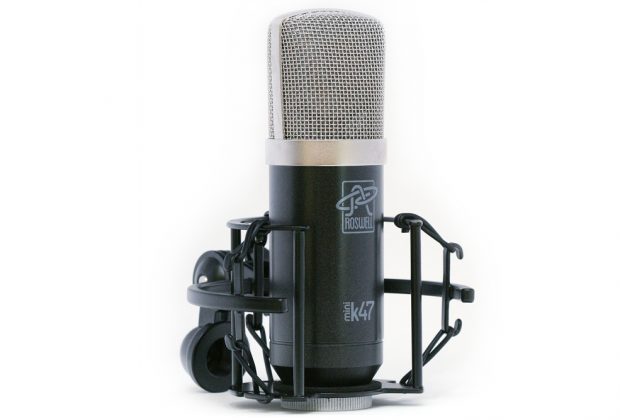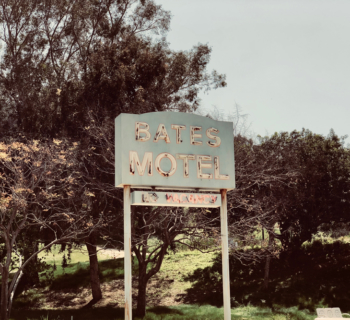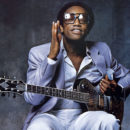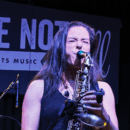The latest iteration of the Roswell Pro Audio's Mini K47 builds on the previous version with improvements on the modified Schoeps circuit including Wima polypropylene film capacitors in the signal path. Built to the specifications of Roswell Pro Audio's owner Matthew McGlynn, a 3-micron thick Mylar, center-terminated 34-mm capsule is used that's modeled after a famous German vocal mic. The super-important J-FET (junction field-effect transistor) that's connected to the capsule is hand-selected and individually biased for the particular capsule and circuit. The Mini K47 uses a true condenser capsule not an electret and requires 48-volt phantom powering.
The Mini K47 is a transformerless design, has a fixed-cardioid pattern and is surprisingly small--just 150mm L X 44mm W and weighs 325 grams. It is about 2/3 the size of the Microphones-Parts.com S-87 I recently built and compared it.
Another significant change is sensitivity. Sensitivity has been lowered to 14 mV/Pa from 18 mV/Pa as in the previous version mic--that's about 2 dB lower. However it retains the same or better signal-to-noise ratio of 81dBA; the equivalent noise is specified at 13dBA. This means, as compared to the way the previous K47 found popular usage in the studio, you'll have more headroom when recording close to loud guitar amps or overhead of drum kits.
Another big change is cosmetic and durability! The new Mini K47's case is powder-coated black instead of painted. Each mic is acoustically tested in 20 microphone batches and the consistent mic-to-mic specs are so close that about half of those 20 mics qualify to be matched pairs.
In The Studio
I was sent a matched pair for this review and I was eager to try them out in the studio and my first test was for drum overheads. The advantage of a matched pair for overhead drums was immediately apparent. Both mics sounded exactly alike, performed identically and put out the same level. Being identical sounding also meant it was easier to set their physical location over the kit; subtle changes in position are obvious and hearable.
n the studio, I measured the distance from the center of the kick drum to the two Minis at 1.4 meters. One Mini was over the rack tom/hi-hat side, and the other over the floor tom/ride cymbal side. I used the studio's API 1608 console with its mic pre-amps at minimum gain and no attenuation pads switched in.
Even though the pre-amps flashed red peaks (on the console) only on snare drum hits, I only had a couple of "flat tops" when inspecting (after the recording) the waveforms of the two overhead tracks in Pro Tools. My drummer played moderately loud and, if he hit harder or if I wanted the mics closer, I would have to switch in the -20dB attenuator pads on the console. With the current distance, I tried using the -20dB pad and I liked the sound too although less of the sound of the drum room's acoustics were present and the low frequencies of the tom-toms diminished. Actually, this flat topping is a function of the console's microphone pre-amps and not the Mini K47 itself. The API 1608 has a lot of gain available.
A small external phantom power supply followed with an inline -10dB attenuator pad would get the big sound without the console mic pre's clipping. I was just fine with the sound as I previously described with an occasional flat top here and there and later I raised the overheads another 50cm and all was good with a little more of the room's sound in the overheads.
Vocals
Next I tried the Mini K47 on vocals. I also wanted to compare the Mini with the S-87 kit mic just to see where these two mics fit in my locker. (As a side note, the S-87 fits into the Mini K47's included shock mount.) For recording narration voiceovers, I used my Sunset Sound S1P pre-amps for both mics with the gain at about 40dB for the S-87 and 50dB for a similar recording level for the Mini K47.
The S-87 is also transformerless but has a different capsule modeled after the Neumann U-87 microphone. I found the Mini K47 to be more open sounding and "richer" sound for vocals compared to the S-87. The Mini also was a little more prone to "p-popping" at similar source-to-mic distances (I don't use wind screens when comparing mics).
The differences are immediately hearable on headphones with S-87 working better (because it has more output level) for quiet to medium loud sources--acoustic guitars and soft vocals. The S-87 is also slightly somber sounding and that is good for bright, strident or shrill voices and sources. It remains a definite "keeper" in my mic locker!
The Mini K47 has slightly more proximity, a touch more mid-range presence (like the U47s as I know them) and a feeling of a bigger and more open dynamic range also like the U47. The Mini is a keeper for larger-than-life vocal sounds for big voice singers!
So I'm recommending getting a pair of Roswell Pro Audio Mini K47s! I always suggest (if possible) buying pro audio gear in pairs and matched microphones are no exception. A great choice for drum overheads, vocals, electric guitar amps or acoustic guitars, the Roswell Pro Audio Mini K47 sells for $299 MAP individually or $699 MAP for a closely matched pair! They come with shock mounts, carrying pouches, and individual carrying cases.
roswellproaudio.com/collections/microphones/products/mini-k47-matched-pair
Barry Rudolph is a recording engineer/mixer who has worked on over 30 gold and platinum records. He has recorded and/or mixed Lynyrd Skynyrd, Hall & Oates, Pat Benatar, Rod Stewart, the Corrs and more. Barry has his own futuristic music mixing facility and loves teaching audio engineering at Musician’s Institute, Hollywood, CA. He is a lifetime Grammy-voting member of NARAS and a contributing editor for Mix Magazine. barryrudolph.com













